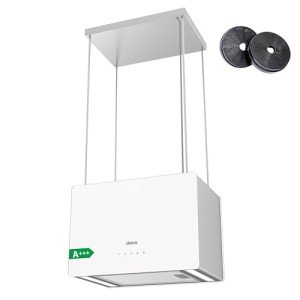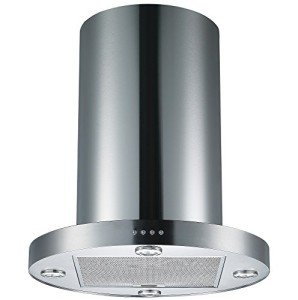You'll Never Guess This Island Ventilation Hoods's Tricks
페이지 정보

본문
A Guide to Island Ventilation Hoods
 Elegant vent hoods make an elegant statement in your kitchen. They're available in a range of designs that match any design. They're likewise functional, permitting you to eliminate cooking smells and airborne grease while providing ventilation.
Elegant vent hoods make an elegant statement in your kitchen. They're available in a range of designs that match any design. They're likewise functional, permitting you to eliminate cooking smells and airborne grease while providing ventilation.
They're available in ductless models that recirculate kitchen air after filtering (fantastic for open-plan kitchen areas) and downdraft vent hoods that pull smoke and steam downward, suitable for minimalist designs.
Aesthetic appeals
The aesthetic appeals of island vent hoods are as differed as the kitchens they are installed in. From smooth to sophisticated, the styles of these appliances make them a centerpiece in any space. Some included ornamental functions like glass canopies and LED lighting to include a visual element to the area. Others include more standard, chimney-style styles that are more practical and useful.
Vent hoods are created to be installed on the wall or integrated into cabinets, so there are plenty of choices offered for various kitchen island extractor hood designs. These hoods likewise differ in size, with smaller models suitable for space-saving designs and larger ones suited to large, open kitchen designs. You can also pick a vented or ductless design, with the latter being perfect for homes without existing ductwork.
One thing to remember is that the height at which a ventilation hood is installed determines how well it can operate. For optimal results, it ought to be between 24 and 30 inches above your cooktop surface. This ensures that it can capture smells, smoke, and steam efficiently while staying inconspicuous to your view when cooking.
A downdraft ventilation system is another alternative for island cookers cooktops. These systems are hidden in the ceiling and increase when triggered, providing a discreet ventilation solution that can be quickly hidden when not in use. These vent hoods work well in minimalist design styles, as they offer a clean, unblocked view of your stovetop.
You can also discover hoods that install to the ceiling straight above your island or other cooktops, such as a peninsula. These are frequently large and provide powerful ventilation to get rid of cooking odors for tidy kitchen air. This kind of hood is frequently more pricey, as it must be extremely effective to draw up smells and smoke from such a range. A few of these hoods likewise come with a telescoping chimney that expands when in usage and withdraws to the ceiling when not in use. If you choose a more unobtrusive style, you can also select a hood that is recessed into the island countertop.
Effectiveness
One of the main functions of island vent hoods is to pull smoke, steam, and odors far from your kitchen. This assists to keep your cooking area tidy and fresh, along with the surrounding rooms in your house. In addition, it can help prevent airborne grease from congesting your walls, ceilings, and other surface areas, saving you the inconvenience of frequent cleaning.
Many island vent hoods are highly effective, utilizing effective motors to catch and disperse air-borne contaminants. They likewise have a smooth style that works well with modern cooking areas. As an added bonus offer, numerous models feature integrated lighting for better exposure when you're cooking at nights.
Choosing the best island range hood for your kitchen is necessary for maximum effectiveness and performance. To make the ideal choice, consider your area, cooking habits, and budget. Whether you desire a fundamental model or something more advanced, it's important to check out the manufacturer's instructions thoroughly before installation.
The key to a reliable island ventilation hood is its blower, which draws in smoke and steam, filters it, and expels it through the ductwork. The majority of manufacturers use a large range of blower sizes and speeds, so you can discover the ideal suitable for your kitchen. They likewise provide a number of types of ductwork, including metal and flexible tubing. A few of them include a damper to prevent outdoors air from getting in the duct when the fan is not running.
Some vent hoods use recirculating filters instead of external ducting. They work by filtering the inbound air with charcoal, and after that returning it to your kitchen. Nevertheless, it's constantly more suitable to vent the contaminated air out of your house, rather than recirculating it.
The most common kind of island hood is ducted. This utilizes a metal duct that leads the air to the exhaust vent outside your home. It's an efficient option if you have enough room for a duct and your home can support it. However, if you're trying to find an ecologically friendly alternative, you can likewise select a ductless island ventilation hood. These are more inexpensive than ducted models, however they might not be as efficient.
Sound
While kitchen hoods play an important function in the health of your cooking environment by getting rid of smoke, smells, and grease from the air, they can likewise be rather noisy. However, there are several strategies that can be utilized to decrease kitchen hood sound and take pleasure in a quieter cooking experience.
Among the most significant factors that can contribute to kitchen hood sound is the blower size. A smaller sized blower will generate more noise than a larger blower when producing equal CFM's. This is why it is vital to choose a high quality hood with a big blower when possible. Having the ability to increase or decrease the fan speed will likewise reduce kitchen hood sound.
Another element that can cause sound is the kind of filter. Generally, cheap mesh filters create more sound than stainless-steel baffle filters. It is likewise important to examine the filter frequently for cracks or breaks. This will avoid unfiltered air from leaving the hood and entering your home.
The size of the hood and ducting likewise contribute in how much noise is created by the kitchen hood. It is necessary to guarantee that the hood is large enough to record all of the smoke and steam created when you cook. The hood should also be set up at the appropriate height, which is normally 30 inches above the range top.
There are numerous alternatives when it concerns selecting a ventilation hood, including wall mount and island hoods. Ductless designs are likewise readily available and can be an excellent alternative for those who do not have existing ductwork in their homes. Downdraft hoods are likewise offered and can be concealed to help supply a minimalist style.
Before acquiring a kitchen hood, it is necessary to carefully think about the requirements of your cooking location and your total home design. With the variety of styles, designs, and sizes offered, it is possible to find a vent hood that will not only fit your kitchen but likewise enhance its aesthetic. With appropriate installation, a stylish island vent hood can add both function and charm to your kitchen island extractor hood while improving the total value of your home.
Installation
Due to the fact that island ventilation hoods are suspended from the ceiling, they are more complex to install than wall-mounted hoods and generally require some modifications to your home's structure. These aspects can increase installation costs, which is why lots of house owners pick to hire professionals to handle this job.
Ventilation hoods are created to efficiently filter and get rid of smoke, steam, grease, and odors from the air in your kitchen. They likewise enhance kitchen comfort by removing heat and reducing humidity levels.
Whether you're cooking with gas or electric, a quality vent hood will avoid damaging fumes from entering the kitchen. Furthermore, they can minimize the amount of grease deposited on your range and surrounding surface areas.
Island hoods are available in duct-out (which conveys drawn out air exterior) and recirculating mode (which captures odors and returns filtered air to the kitchen without the requirement for a chimney or exhaust hole). They can be mounted on either the ceiling or above your cooktop or range.
Before trying to mount an island hood yourself, ensure you have the correct tools and knowledge. This task involves eliminating and drilling holes in your ceiling, running electrical wiring, and installing the vent cover. It's important to keep in mind that if you prepare to utilize a vented hood, it must be linked to an outside air vent or your home might experience carbon monoxide gas poisoning.
To begin, you'll require to figure out the size of your vent. This can be done by measuring the diameter of the hood's filter, or by utilizing a caliper to measure the distance in between each hole in the vent's interior. After you've determined the proper size, it's time to eliminate your vent hole in the ceiling.
When you've made the appropriate hole in your ceiling, you'll need to run your electrical wiring from the breaker box to the hood's electrical terminal box. Be sure to follow the maker's particular instructions for this step.
 Once your hood is set up, you can turn it on and check it for functionality. If you're not satisfied with the efficiency, it's a good concept to work with a professional for more comprehensive screening.
Once your hood is set up, you can turn it on and check it for functionality. If you're not satisfied with the efficiency, it's a good concept to work with a professional for more comprehensive screening.
 Elegant vent hoods make an elegant statement in your kitchen. They're available in a range of designs that match any design. They're likewise functional, permitting you to eliminate cooking smells and airborne grease while providing ventilation.
Elegant vent hoods make an elegant statement in your kitchen. They're available in a range of designs that match any design. They're likewise functional, permitting you to eliminate cooking smells and airborne grease while providing ventilation.They're available in ductless models that recirculate kitchen air after filtering (fantastic for open-plan kitchen areas) and downdraft vent hoods that pull smoke and steam downward, suitable for minimalist designs.
Aesthetic appeals
The aesthetic appeals of island vent hoods are as differed as the kitchens they are installed in. From smooth to sophisticated, the styles of these appliances make them a centerpiece in any space. Some included ornamental functions like glass canopies and LED lighting to include a visual element to the area. Others include more standard, chimney-style styles that are more practical and useful.
Vent hoods are created to be installed on the wall or integrated into cabinets, so there are plenty of choices offered for various kitchen island extractor hood designs. These hoods likewise differ in size, with smaller models suitable for space-saving designs and larger ones suited to large, open kitchen designs. You can also pick a vented or ductless design, with the latter being perfect for homes without existing ductwork.
One thing to remember is that the height at which a ventilation hood is installed determines how well it can operate. For optimal results, it ought to be between 24 and 30 inches above your cooktop surface. This ensures that it can capture smells, smoke, and steam efficiently while staying inconspicuous to your view when cooking.
A downdraft ventilation system is another alternative for island cookers cooktops. These systems are hidden in the ceiling and increase when triggered, providing a discreet ventilation solution that can be quickly hidden when not in use. These vent hoods work well in minimalist design styles, as they offer a clean, unblocked view of your stovetop.
You can also discover hoods that install to the ceiling straight above your island or other cooktops, such as a peninsula. These are frequently large and provide powerful ventilation to get rid of cooking odors for tidy kitchen air. This kind of hood is frequently more pricey, as it must be extremely effective to draw up smells and smoke from such a range. A few of these hoods likewise come with a telescoping chimney that expands when in usage and withdraws to the ceiling when not in use. If you choose a more unobtrusive style, you can also select a hood that is recessed into the island countertop.
Effectiveness
One of the main functions of island vent hoods is to pull smoke, steam, and odors far from your kitchen. This assists to keep your cooking area tidy and fresh, along with the surrounding rooms in your house. In addition, it can help prevent airborne grease from congesting your walls, ceilings, and other surface areas, saving you the inconvenience of frequent cleaning.
Many island vent hoods are highly effective, utilizing effective motors to catch and disperse air-borne contaminants. They likewise have a smooth style that works well with modern cooking areas. As an added bonus offer, numerous models feature integrated lighting for better exposure when you're cooking at nights.
Choosing the best island range hood for your kitchen is necessary for maximum effectiveness and performance. To make the ideal choice, consider your area, cooking habits, and budget. Whether you desire a fundamental model or something more advanced, it's important to check out the manufacturer's instructions thoroughly before installation.
The key to a reliable island ventilation hood is its blower, which draws in smoke and steam, filters it, and expels it through the ductwork. The majority of manufacturers use a large range of blower sizes and speeds, so you can discover the ideal suitable for your kitchen. They likewise provide a number of types of ductwork, including metal and flexible tubing. A few of them include a damper to prevent outdoors air from getting in the duct when the fan is not running.
Some vent hoods use recirculating filters instead of external ducting. They work by filtering the inbound air with charcoal, and after that returning it to your kitchen. Nevertheless, it's constantly more suitable to vent the contaminated air out of your house, rather than recirculating it.
The most common kind of island hood is ducted. This utilizes a metal duct that leads the air to the exhaust vent outside your home. It's an efficient option if you have enough room for a duct and your home can support it. However, if you're trying to find an ecologically friendly alternative, you can likewise select a ductless island ventilation hood. These are more inexpensive than ducted models, however they might not be as efficient.
Sound
While kitchen hoods play an important function in the health of your cooking environment by getting rid of smoke, smells, and grease from the air, they can likewise be rather noisy. However, there are several strategies that can be utilized to decrease kitchen hood sound and take pleasure in a quieter cooking experience.
Among the most significant factors that can contribute to kitchen hood sound is the blower size. A smaller sized blower will generate more noise than a larger blower when producing equal CFM's. This is why it is vital to choose a high quality hood with a big blower when possible. Having the ability to increase or decrease the fan speed will likewise reduce kitchen hood sound.
Another element that can cause sound is the kind of filter. Generally, cheap mesh filters create more sound than stainless-steel baffle filters. It is likewise important to examine the filter frequently for cracks or breaks. This will avoid unfiltered air from leaving the hood and entering your home.
The size of the hood and ducting likewise contribute in how much noise is created by the kitchen hood. It is necessary to guarantee that the hood is large enough to record all of the smoke and steam created when you cook. The hood should also be set up at the appropriate height, which is normally 30 inches above the range top.
There are numerous alternatives when it concerns selecting a ventilation hood, including wall mount and island hoods. Ductless designs are likewise readily available and can be an excellent alternative for those who do not have existing ductwork in their homes. Downdraft hoods are likewise offered and can be concealed to help supply a minimalist style.
Before acquiring a kitchen hood, it is necessary to carefully think about the requirements of your cooking location and your total home design. With the variety of styles, designs, and sizes offered, it is possible to find a vent hood that will not only fit your kitchen but likewise enhance its aesthetic. With appropriate installation, a stylish island vent hood can add both function and charm to your kitchen island extractor hood while improving the total value of your home.
Installation
Due to the fact that island ventilation hoods are suspended from the ceiling, they are more complex to install than wall-mounted hoods and generally require some modifications to your home's structure. These aspects can increase installation costs, which is why lots of house owners pick to hire professionals to handle this job.
Ventilation hoods are created to efficiently filter and get rid of smoke, steam, grease, and odors from the air in your kitchen. They likewise enhance kitchen comfort by removing heat and reducing humidity levels.
Whether you're cooking with gas or electric, a quality vent hood will avoid damaging fumes from entering the kitchen. Furthermore, they can minimize the amount of grease deposited on your range and surrounding surface areas.
Island hoods are available in duct-out (which conveys drawn out air exterior) and recirculating mode (which captures odors and returns filtered air to the kitchen without the requirement for a chimney or exhaust hole). They can be mounted on either the ceiling or above your cooktop or range.
Before trying to mount an island hood yourself, ensure you have the correct tools and knowledge. This task involves eliminating and drilling holes in your ceiling, running electrical wiring, and installing the vent cover. It's important to keep in mind that if you prepare to utilize a vented hood, it must be linked to an outside air vent or your home might experience carbon monoxide gas poisoning.
To begin, you'll require to figure out the size of your vent. This can be done by measuring the diameter of the hood's filter, or by utilizing a caliper to measure the distance in between each hole in the vent's interior. After you've determined the proper size, it's time to eliminate your vent hole in the ceiling.
When you've made the appropriate hole in your ceiling, you'll need to run your electrical wiring from the breaker box to the hood's electrical terminal box. Be sure to follow the maker's particular instructions for this step.
 Once your hood is set up, you can turn it on and check it for functionality. If you're not satisfied with the efficiency, it's a good concept to work with a professional for more comprehensive screening.
Once your hood is set up, you can turn it on and check it for functionality. If you're not satisfied with the efficiency, it's a good concept to work with a professional for more comprehensive screening.- 이전글Your Family Will Be Grateful For Having This Audi Key 25.04.02
- 다음글What's The Current Job Market For Link Daftar Gotogel Professionals? 25.04.02
댓글목록
등록된 댓글이 없습니다.



 02.6010.5010
02.6010.5010




